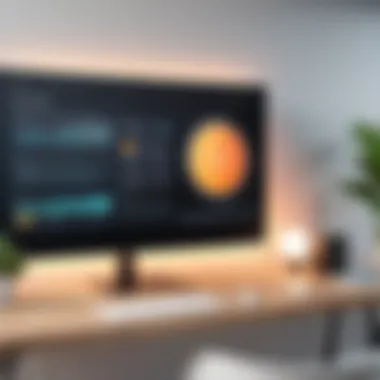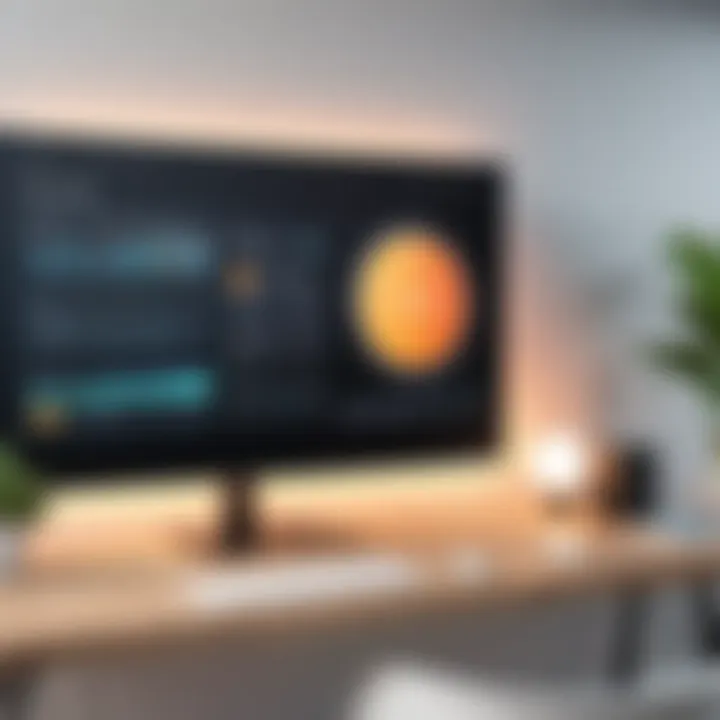Exploring Virtual Staging Software for Real Estate


Intro
Virtual staging software is shaking things up in the real estate and interior design sectors. The traditional method of staging properties—using physical furniture and decor to enhance appeal—demands significant time, resources, and money. Enter virtual staging: it transforms images of empty or outdated spaces into stunning visual representations that capture the imagination of potential buyers. This article will take you on a journey through the landscape of virtual staging, examining its capabilities, advantages, and implications for both industry professionals and clients.
With a surge in digital technology, the way properties are presented is evolving. Virtual staging is not just a passing trend; it’s a pivotal tool that shapes sales dynamics. Let’s unpack how this technology influences property presentation and client engagement, providing insights that are vital for making informed decisions in software selection and usage.
Brief Description
Overview of the Software
Virtual staging software allows users to digitally furnish and decorate a property using powerful image manipulation tools. By placing realistic furniture, art, and decorative pieces into photographs of empty rooms, users can create inviting environments that spark interest. This process can be carried out quickly compared to traditional staging methods, eliminating delays and minimizing costs.
Key Features and Functionalities
- User-Friendly Interface: Most of these programs boast intuitive interfaces that allow even novices to create appealing designs with ease.
- Diverse Furniture and Decor Options: An extensive library of furniture styles, colors, and accessories means users can tailor the appeal to various target demographics.
- 3D Visualization: Some software packages offer advanced 3D modeling capabilities, allowing clients to view spaces from multiple angles and perspectives.
- High-Quality Renderings: Professional-looking images are essential for marketing. Many virtual staging tools can produce high-resolution images that stand out on listings.
"Virtual staging software not only enhances images but also significantly reduces the carbon footprint associated with traditional staging methods."
System Requirements
Hardware Requirements
To reap the full benefits of virtual staging software, users should consider the following minimal hardware setup:
- A desktop or laptop computer with at least 8GB of RAM.
- A modern graphics card capable of handling 3D rendering—this is crucial for smooth performance.
- Adequate storage space to host high-resolution images and the software itself.
Software Compatibility
Most virtual staging applications are designed for compatibility with various operating systems, including Windows and macOS. Additionally, some platforms offer cloud-based solutions that allow for work on any device with an internet connection, providing flexibility for users.
Preface to Virtual Staging Software
The field of virtual staging software is truly revolutionary, impacting how properties—both residential and commercial—are presented to potential buyers. As the real estate market becomes increasingly competitive, utilizing effective tools can make all the difference. This article sets out to clarify how virtual staging can elevate property marketing, and it’ll delve into its foundational aspects, advantages, and potential pitfalls.
Definition and Overview
Virtual staging software refers to digital solutions that allow users to create realistic representations of spaces by adding furniture and decor in a virtual format. It effectively transforms bare or unfurnished spaces into beautifully designed environments, without the need for physical staging. Such software offers a cost-effective and efficient alternative to traditional staging processes, allowing agents and sellers to showcase potential.
This tech employs advanced algorithms and design principles, enabling users to visualize how a property might look with different furnishings. The software enables agents to produce high-quality images for listings without the hefty price tag of physical staging, appealing directly to buyers' imaginations. In a nutshell, it's like dressing up a home, but in the digital realm, making it visually appealing without any heavy lifting.
Historical Context and Evolution
The origins of virtual staging can be traced back to the advancements in graphic design software during the late 1990s and early 2000s. Initially, it was primarily used in architectural illustrations, but as consumer demand for real estate grew, innovative minds took that technology and adapted it for property marketing. Today, it’s not just the tools that have evolved; the techniques have also matured significantly.
In the early days, virtual staging was rudimentary at best. Images often appeared flat and lacked the warmth that physical stage settings offered. However, with the emergence of high-quality 3D modeling software and powerful rendering engines, virtual staging took a major leap forward. Now, prospects can see floor plans come to life, complete with lifelike textures and shadows, providing an immersive experience. This evolution reflects a broader trend in the digital domain, where homeowners and buyers want to see possibilities, not limitations.
As we look ahead, it’s clear that virtual staging software continues to adapt and embrace newer technologies. With the integration of augmented reality and machine learning, the future seems bright for this innovative tool, turning tired listings into fresh opportunities every day.
Core Features of Virtual Staging Software
Understanding the essential elements of virtual staging software shines a light on its remarkable capabilities. The core features play a pivotal role, making it effective and accessible for a range of users—from real estate agents to interior designers. Diving into the details of these functionalities reveals not only their benefits, but also the thoughtful considerations that should inform any decision regarding software selection.
User-Friendly Interface
A user-friendly interface is foundational when it comes to virtual staging software. This aspect can truly make or break the user experience. For instance, imagine trying to navigate complex software under the pressure of a ticking clock as a listing date looms. A clear, intuitive layout encourages users to explore and utilize all features effectively. Minimalist designs with straightforward menus often lead to untroubled engagements, allowing users—regardless of technical know-how—to place furniture, adjust colors, or modify layouts without feeling overwhelmed.
Additionally, drag-and-drop functionality has become a hallmark of effective user interfaces, enabling quick adjustments that resonate with fast-paced real estate environments. User feedback often emphasizes the frustration associated with poorly designed interfaces, which can drastically hinder productivity. Thus, while exploring the software, testing its interface can reveal a lot about how it aligns with workplace needs.
3D Visualization Capabilities
The magic of virtual staging becomes palpably clear through its 3D visualization capabilities. This feature transforms flat images into immersive environments, making potential buyers feel like they are stepping into a home, rather than merely viewing it. High-quality renderings give a lifelike perspective, allowing clients to envision spaces in a way flat images simply cannot capture. It's the difference between reading a menu and tasting a dish—one can spark interest, but it’s the latter that fosters desire.
Moreover, advanced rendering options create shadows, light reflections, and textures that add depth to virtual designs. This enhances emotional engagement and positively influences the perception of space. Some software even allows for real-time adjustments, enabling clients to see changes as they occur, maintaining their interest and investment in the viewing process.
Furniture and Decor Libraries
A diverse collection of furniture and decor options can provide users a palette for creativity. Virtual staging software that includes extensive libraries allows for a tailored experience, catering to various tastes and design preferences. For example, a listing designed for a family home may feature soft, inviting furniture while a contemporary apartment could benefit from sleek, modern designs.
Moreover, regular updates to these libraries ensure that they reflect current trends and user demands. Having access to the latest furniture styles can significantly boost appeal. As users stage different properties, the ability to mix and match elements from these libraries enhances uniqueness in each project.
Customizable Elements
Customization options are crucial to fully leverage the potential of virtual staging software. Templates that can be adapted to meet specific needs mean that users can lend their personal flair to each project. This can range from changing color schemes and fabrics to adjusting the scale of objects to fit the room precisely—a balance is essential.
Furthermore, allowing for user-selected adjustments can be particularly beneficial during client presentations. If a client wishes for a more vibrant use of color or changes to the arrangement of furniture, being able to make these tweaks in real-time can create a more collaborative atmosphere. Such flexibility fosters a sense of ownership in the design process, potentially leading to higher satisfaction rates.
"A simple but effective design can communicate ideas faster and improve user satisfaction."
— Design Expert


Overall, effective virtual staging software is characterized by its user-friendly interface, stunning 3D visualizations, comprehensive furniture libraries, and robust customization options. Each feature reinforces the software's ability to meet diverse client needs while crafting compelling property presentations that enhance sales opportunities.
Types of Virtual Staging Software
Understanding the different types of virtual staging software is essential for real estate professionals and interior designers alike. Each type comes packed with its own set of features and benefits, catering to various needs, preferences, and problem-solving requirements. The significant range allows users to select solutions that align with their project scope, skills, and operational demands. Let’s take a closer look at the prominent categories:
Cloud-Based Solutions
Cloud-based virtual staging software has made quite a mark lately. These platforms operate online, requiring users to connect to the internet to access their tools and resources. Think of it as having a toolbox that resides in the cloud and you only need to log in to use it.
Benefits include:
- Accessibility: Access from anywhere, which can be a game changer for remote teams or those on the go.
- Collaboration: Easily share designs and collaborate with clients or colleagues in real-time.
- Automatic Updates: The software is often updated automatically by the provider, ensuring users always have access to the latest features.
However, keep in mind that on occasion you might run into issues if your internet connection falters. Moreover, you’ll want to assess the ongoing subscription costs, which can add up over time.
"The cloud provides limitless opportunities, but it can also lead to unpredictable hurdles in connectivity."
Desktop Software Options
Desktop software solutions offer a different flavor. Users download and install these programs directly onto their machines, meaning they can often work offline. They tend to be robust and capable of handling complex rendering tasks without needing a constant internet line.
Key aspects of desktop solutions include:
- Speed: They can often render high-quality images faster as they utilize the computer’s power.
- Simplicity: Once installed, users don’t have to worry about logins or data being managed online, which can provide a sense of control.
- One-time Purchase: While some desktop software may require a hefty upfront cost, often there's no ongoing subscription fee, making it potentially cost-effective in the long run.
However, the tradeoff is that they might not have the collaborative features seen in their cloud counterparts. If you’re working with teams or clients who aren’t in the same location, sync may be a challenge.
Mobile Applications
The rise of mobile applications in virtual staging brings creativity right to the palm of your hand. These apps are designed for quick editing and on-the-go solutions, making it easier for agents to stage properties with just a few taps.
Key features of mobile applications include:
- Convenience: Quickly snap a photo of a space and stage it in real-time, allowing for spontaneous decisions or showcasing on social media without desktops.
- User-Friendly: Many mobile applications have intuitive interfaces, making them accessible even for users with minimal experience.
- Cost-effective: A number of quality apps come at a fraction of the cost of full desktop software, making them ideal for those just starting out or working with a limited budget.
On the downside, they may lack the full functionality or quality of rendering compared to desktop or cloud solutions—but they sure do offer fantastic flexibility!
In summary, assessing the types of virtual staging software is crucial to find what suits your needs best. It’s not a one-size-fits-all situation—so choose wisely!
Benefits of Using Virtual Staging Software
Virtual staging software has carved a niche for itself in the realm of real estate and interior design. Its rising prominence is not merely a passing trend; it brings a plethora of advantages that reshape how properties are showcased to potential buyers. This section dives into the key benefits that virtual staging software offers and why considering these elements can significantly impact marketing strategies and overall sales success.
Cost Efficiency Compared to Traditional Staging
One of the most striking advantages of virtual staging is its cost efficiency. Traditional staging often involves renting furniture, hiring professionals, and potentially making structural changes to the property, all of which can accumulate considerable expenses. Virtual staging, in contrast, requires a one-time fee for software access or a pay-per-image model, which means the costs don’t spiral out of control.
Here are key points on the financial side of virtual staging:
- Lower Initial Costs: No need to purchase or rent bulk furniture. The software provides digital imagery instead.
- Less Time Investment: Quick turnaround times minimize labor costs related to setting up physical spaces.
- No Physical Damage: Since there’s no actual furniture, the risk of damage from moves or setups is eliminated. This also means less liability for the seller or agent.
"In the highly competitive world of real estate, every dollar counts. Virtual staging offers a budget-friendly alternative that does not skimp on visual appeal."
Flexibility in Design Choices
Flexibility is another hallmark of virtual staging software. While traditional staging can be restrictive, requiring time-consuming selections and physical arrangements, virtual options allow users to experiment with various design elements at the click of a button.
Consider the following when it comes to flexibility:
- Diverse Styles at Hands Reach: Home sellers can showcase different aesthetics—modern, rustic, minimalist—without any additional costs or effort.
- Instant Adjustments: If designs are not hitting the mark, changes can be made instantly based on feedback, something unfeasible with physical setups.
- Room Repurposing: A single space can be shown as a bedroom, office, or playroom, depending on the market needs, thereby attracting a wider audience.
Enhanced Marketing Strategies
Finally, virtual staging can transform marketing strategies for real estate agents and homeowners alike. High-quality, visually appealing images generated through staging software can make listings stand out in a crowded market.
Here are ways in wich virtual staging enhances marketing:
- High-Quality Visuals: Professional-looking photos can be created in minutes, helping listings to pop even on crowded social media platforms like Facebook or real estate sites.
- Broader Reach: With more eye-catching images, properties can attract a more significant number of potential buyers and allow for different marketing avenues, like targeted ads.
- Compelling Storytelling: Virtual staging allows sellers to create narratives around spaces, helping buyers envision their future life in the home, which can be more persuasive than cold, vacant images.
The impact that virtual staging software has goes beyond just visual aesthetics; it reshapes marketing approaches, influences buyer perceptions, and ultimately drives sales effectiveness. Embracing these benefits can lead to smarter, more efficient strategies for property presentation.
Leveraging these aspects can help anyone from seasoned agents to first-time sellers maneuver through the often tricky landscape of real estate with confidence and ease.
Challenges in Virtual Staging
In navigating the world of virtual staging software, one cannot overlook the hurdles that accompany its use. While this technology has revolutionized how properties are presented, it also comes with challenges that stakeholders must acknowledge. Addressing these challenges is crucial as they can impact user experience, client satisfaction, and ultimately the success of the staging process. This exploration centers on key elements like technical limitations, the quality of rendered images, and common misunderstandings among clients.
Technical Limitations


Despite the advantages of virtual staging, it is not without its technical warts. Users often face limitations based on the device they’re using or the software capabilities. Not all software is created equal; some may struggle with high-resolution images or lack the necessary rendering speed. For instance, if you’re using an outdated computer, software that requires heavy computation might run sluggish, causing frustration during the design process. Moreover, compatibility issues can arise when trying to integrate tools or features from different providers.
Additionally, there are constraints on customization. While many software options boast a plethora of furniture and decor libraries, adapting these elements to a specific aesthetic remains a challenge. In some cases, users may find that the selections available don’t align with the vision they have in mind.
"Navigating the software's limitations can feel a bit like swimming upstream without a paddle."
Quality of Rendered Images
The quality of rendered images is another sticking point in the realm of virtual staging. While many platforms strive to provide high-quality visuals, not all software achieves the desired realism. This gap can lead to widespread disappointment, particularly when clients have high expectations. Images that don’t look life-like can undermine potential buyers' confidence in the property, detracting from the effectiveness of the staging.
Furthermore, factors such as lighting and texture can vary significantly between different software applications. Users may find that what looks stunning in the application doesn’t translate when published or shared online. This discrepancy can leave clients puzzled, making it essential for professionals to set clear expectations before embarking on virtual staging projects.
Misunderstandings by Clients
Clients often come into a virtual staging interaction with preconceived notions about its capabilities, which can lead to misunderstandings. Some clients might believe that virtual staging can transform any space into a magazine-cover scene, overlooking the inherent limitations of the technology. They may expect the staging to defy logical constraints, which leads to unreasonable demands and disappointment when the final product doesn’t meet their inflated expectations.
An additional layer of complexity arises when clients are not fully educated about the distinction between virtual staging and other processes, such as actual physical staging or renovations. Miscommunication is rife, and professionals are often tasked with clarifying these differences. It’s pivotal to foster open dialogue between real estate agents, interior designers, and their clients to bridge this gap.
Comparison with Traditional Staging
When evaluating the effectiveness of virtual staging software, it's crucial to compare it with traditional staging methods. Traditional staging is often seen as a vital step in preparing a property for sale or rent. It involves physically setting up furniture and decor to highlight the space's potential. However, as technology advances, it's important to understand how virtual staging stacks up against these established practices.
Time Requirements
One of the most significant differences between virtual and traditional staging is the time commitment. Traditional staging can be a lengthy process. It requires hiring a staging company or designer, transporting furniture, and physically arranging items in the property. This can take anywhere from a few days to weeks, depending on the size of the space and availability of resources.
In contrast, virtual staging is significantly faster. Most software solutions allow a user to upload an image of a vacant room and start transforming it within minutes. Once the digital images are rendered, agents can share them almost instantly on various platforms. This rapid turnaround is not just life-saving for tight deadlines, it also means that properties can be put on the market quicker, enhancing potential sales opportunities.
"In the fast-paced world of real estate, speed can be the difference between a sale and a missed opportunity."
Impact on Perception
Perception plays a huge role in real estate transactions, and traditional staging often aims to create a welcoming atmosphere that allows potential buyers to envision themselves in a space. When done effectively, physical staging can enhance the appeal of a property tremendously, showing off its best features and potential uses.
On the other hand, virtual staging has the unique ability to manipulate perception in different ways. It allows for a range of styles and themes without the need for physical representation. Users can showcase a variety of design options that cater to diverse tastes. This flexibility can attract different buyer demographics, as each buyer may have their distinct vision of how a space can serve them.
However, it’s also worth noting that virtual staging can sometimes lead to misunderstandings. Prospective buyers might develop expectations that are not aligned with reality, based on the virtual images. If a person overlooks the intricacies of the space due to a heavily staged virtual image, it could lead to dissatisfaction when they view the property in person.
In summary, the comparison between traditional and virtual staging is layered with advantages and disadvantages. While traditional staging excels in tangible impact, virtual staging shines in speed and flexibility. Understanding these differences allows buyers and sellers to make educated decisions about how best to present a property.
Key Considerations for Selection
Selecting the right virtual staging software is like navigating a maze – you have to be mindful of various factors to ensure you don’t end up at a dead end. With plenty of options available, there’s no one-size-fits-all solution. Recognizing the vital elements in your selection process can empower real estate professionals, interior designers, and small business owners to make informed decisions that can enhance their property presentations.
Budget Constraints
When it comes to software, the budget is often a deciding factor. Virtual staging software can vary widely in cost, from affordable options with limited functionality to high-end tools loaded with features. It's essential to scrutinize what each software offers in relation to its price. Consider these factors:
- Initial Costs: Some programs have a one-time fee, while others require a subscription.
- Ongoing Expenses: Look for hidden costs related to updates or additional content packs.
- Value for Money: Assess how the features align with your needs versus how much you’re spending.
Staying within budget while meeting your needs is crucial.
Features and Usability
Once the budget is set, the next step is evaluating features and usability. A complex software with numerous capabilities can sometimes hinder rather than help. It's crucial that the chosen software ticks the boxes in both areas:
- Intuitive Interface: Simplicity is key. A user-friendly layout can significantly reduce the learning curve.
- Essential Tools: Ensure it provides the basic features required for staging. 3D visualizations, customizable elements, and a robust library of furniture and decor should be a given.
- Compatibility: The software should seamlessly integrate with other tools and platforms you might use for your design and marketing workflows.
Finding a balance between robust features and straightforward usability can be crucial, particularly for professionals who might not have extensive technical expertise.
Support and Community Feedback
Last but not least, it's wise to consider the level of support and community engagement around the software. Navigating a new application can often lead to questions or hiccups, and understanding how a company addresses these issues can make a world of difference:
- Customer Support: Check if the company offers prompt assistance through various channels like chat, email, or phone.
- User Reviews: Look for feedback on platforms such as Reddit or specialized forums. Real user experiences can shine a light on potential issues or advantages that don’t often make it into marketing materials.
- Community Presence: A supportive community can be invaluable, not just for troubleshooting problems, but also for inspiring creative uses of the software.
In the world of virtual staging, the right technology can shift the needle on property sales. The finer points, like support and community feedback, can be just as critical as the software itself.
Future Trends in Virtual Staging Software
As we stand on the shoulder of technological giants, the realm of virtual staging software continues to evolve, reflecting broader trends in real estate and design. Understanding these future trends is essential, as they not only indicate where the industry is heading but also how businesses can strategically position themselves to harness upcoming opportunities.
The increasing integration of artificial intelligence and machine learning will transform the way virtual staging software operates, leading to more personalized and efficient experiences for both users and clients. Furthermore, the adoption of augmented reality enhancements promises to shift the paradigm, allowing potential buyers to visualize spaces in ways that were previously unimaginable. These advancements will enable real estate professionals and interior designers to create seamless, immersive presentations that resonate with their audience.
Integration of AI and Machine Learning
The incorporation of AI and machine learning into virtual staging is more than just a trend; it's becoming a cornerstone for innovation. Imagine a scenario where the software learns user preferences over time, offering tailored furniture selections or design styles based on past interactions. This capability to predict what clients might prefer can streamline the staging process significantly.


Benefits of AI integration include:
- Efficient Design Recommendations: AI can analyze current market trends and suggest furniture that aligns with buyer preferences.
- Automation of Repetitive Tasks: Routine tasks, like resizing images or layout adjustments, can be automated, allowing stagers to focus on more creative aspects.
- Enhanced Analytic Tools: Machine learning can identify successful staging techniques from historical data, helping users implement strategies that have previously driven sales.
This predictive design assistance can equally benefit sellers and buyers, providing a more engaging and satisfying experience.
Augmented Reality Enhancements
Augmented reality (AR) is making waves in numerous sectors, and virtual staging is no exception. By integrating AR into virtual staging software, users can virtually place furniture in real-world settings via their smartphones or tablets. This allows potential buyers to see how specific pieces fit into an actual space, enhancing their decision-making process.
Key aspects of AR in virtual staging include:
- Real-Time Visualization: Clients can manipulate design elements in real-time, moving furniture around or changing colors with just a swipe.
- Increased Engagement: Interactive experiences keep clients engaged longer, improving the likelihood of purchase decisions.
- Reduced Uncertainty: Clients can visualize how their style choices will look in a property, reducing doubts that might deter a sale.
In a nutshell, these technologies are shaping the way properties are showcased and perceived. They are not merely enhancements but rather fundamental shifts in how real estate professionals engage with their clients.
"Adopting these advancements today will be pivotal for staying competitive in tomorrow's market."
As companies delve into these emerging technologies, they can expect to see improved client relationships and potentially skyrocket their sales percentages. Being forward-thinking will be paramount in the fast-paced world of real estate.
Case Studies: Successful Implementations
The discussion around virtual staging software isn't complete without examining real-world applications. Case studies illuminate the practical utility of this technology in various scenarios, showcasing its transformative effects on both residential and commercial markets. These examples not only underscore the success stories but also reveal valuable lessons learned along the way.
Residential Properties
In the realm of residential properties, case studies highlight how virtual staging can make a significant difference in property presentations. One noteworthy example involves a mid-size home in a competitive market. The property initially sat unsold for several months, with traditional staging failing to capture potential buyers’ interest. By implementing virtual staging, the owner showcased the home's potential, utilizing a vibrant design that highlighted spaciousness and functionality.
"Investing in virtual staging turned our property from overlooked into desirable. We received an offer within weeks!" – Homeowner from a case study on Effectiveness.
The results spoke volumes. After the virtual staging was completed, the property not only received more traffic but also sold for a price above the owner's expectations. Notably, the software allowed the homeowner to showcase various decor styles, catering to a wider range of buyer tastes. This flexibility in design choices serves as a critical element, enhancing presentations and ultimately driving sales.
Furthermore, virtual staging reduces costs typically associated with physical staging. A recent analysis showed that many home sellers saved anywhere from 50% to 75% in costs by opting for digital staging solutions. The sheer convenience of being able to change the look without lifting a finger is a game changer for many homeowners.
Commercial Spaces
Commercial spaces also benefit significantly from virtual staging practices. A striking instance involves a downtown office space that struggled to attract tenants. Initially presented empty, potential renters couldn't visualize how the space could be utilized effectively. Just like flipping a switch, a virtual staging application was employed to furnish the space virtually, presenting various configurations from collaborative workspaces to formal meeting rooms.
The change was palpable. Almost instantly, inquiries tripled, leading to successful leasing within a month. This case illustrates that visualization is key; it helps potential clients see how they can use the space to meet their business needs effectively. Moreover, by showcasing multiple design options, it assists in addressing diverse requirements of different companies.
In summary, case studies in both residential and commercial settings reveal the profound impact of virtual staging software. They serve as prime examples of how embracing technology can yield tangible results—transforming properties into compelling offers that resonate with potential buyers and tenants alike.
As the landscape of real estate continues to evolve, the integration of virtual staging seems not just beneficial but essential for success in today's highly competitive markets.
User Reviews and Experiences
Understanding user feedback is vital in grasping the full impact of virtual staging software. Reviews illuminate not just the strengths of the tools, but also their weaknesses. This insight is crucial, especially for real estate agents and interior designers, who heavily rely on these platforms to present properties or spaces attractively.
User experiences offer a glimpse into the usability, functionality, and overall satisfaction derived from the software. By analyzing these reviews, stakeholders can make informed decisions based on real-world applications rather than mere testaments from marketing collateral.
Moreover, user reviews encourage transparency. Potential buyers or users can gauge the reliability and effectiveness of the software, uncovering how it has helped fellow users. This kind of social proof can be a game changer, leading to trust in new technologies during the selection phase.
Feedback from Real Estate Agents
Real estate agents often provide the frontline perspective on how virtual staging software impacts their daily work. Many agents express that their choice of software shapes how effectively they can market a property.
- Efficiency in Marketing: Numerous agents mention that tools like BoxBrownie or Virtual Staging Solutions have dramatically reduced the time spent preparing listings. In a market that waits for no one, efficiency can be the difference between closing a deal or watching an opportunity slip away.
- Client Satisfaction: Agents report that clients are usually impressed with the virtual representation of their properties. A well-staged image can tug at the heartstrings, driving potential buyers to act more quickly. This is especially key in luxury markets where visual appeal is paramount.
- Easy Customization: Many agents appreciate how these tools allow for easy updates to visuals. As tastes change or as a property evolves, the ability to quickly modify images to reflect the latest look keeps listings feeling fresh.
Despite the positive feedback, some agents note that they experienced learning curves. Simple training modules or customer support from the software provider could smoothen this process. Feedback also suggests a need for more intuitive interfaces to minimize technical issues that may arise during the staging process.
Insights from Interior Designers
Interior designers approach virtual staging through a creative lens. Their requirements diverge slightly from real estate agents, focusing more on aesthetics and detail. Insights from these professionals build a nuanced understanding of software strengths and drawbacks.
- Realism and Detail: Designers emphasize the importance of realism in virtual renditions. Software programs like Cedreo and Homestyler have been praised for allowing designers to achieve lifelike representations. This creates an authentic feel that resonates with clients who may visualize their future space differently.
- Collaboration Opportunities: Many designers value the collaboration tools offered by some staging software. They appreciate the ability to share staged images with clients in real-time, enabling immediate feedback and adjustments. This fosters a more interactive design process.
- Versatility in Design Styles: A significant point brought up by designers is the software’s ability to cater to various styles—be it contemporary, rustic, or eclectic. Flexibility allows designers to showcase their skills in a way that aligns with their design philosophy.
Yet, challenges remain. Designers sometimes find limitations in the available furniture or decor options, which can stifle their creativity. Therefore, choosing a platform that routinely updates its library could be beneficial to ensure a fresh approach.
"Feedback from users is not just valuable data; it's the lifeblood of software evolution."
End
In this article, we've traversed the landscape of virtual staging software, uncovering its essence and its multifarious implications. The role of virtual staging in real estate and interior design is not merely as a tool; it symbolizes a shift in how properties are visualized and marketed. The advantages offered by these innovative solutions are profound, encompassing cost-effectiveness, enhanced marketability, and versatility in artistic expression.
Summarizing Key Takeaways
- Adoption of Technology: Integrating virtual staging software can significantly streamline property showcasing. Agents and sellers alike save both time and money via digitized solutions.
- User Experience: A intuitive interface coupled with 3D visualization capabilities enables users—from agents to property developers—to create stunning presentations that catch the eye.
- Diverse Options: The availability of varied software types, be it cloud-based, desktop, or mobile applications, allows all potential users to select what aligns perfectly with their specific needs.
- Balancing Challenges and Rewards: While challenges like image quality and tech limitations exist, the benefits outweigh them in most cases. It's essential to understand these pitfalls to mitigate them effectively.
Looking Ahead: The Role of Virtual Staging Software
As we gaze into the future, the significance of virtual staging software is bound to grow. Innovations such as AI enhancements and augmented reality features are on the horizon, promising to transform how properties are experienced digitally. Expect to see:
- AI Integration: Artificial intelligence will lead to smarter design suggestions, helping users visualize various spaces tailored to their tastes in mere seconds.
- Augmented Reality: Imagine viewing a property through your smartphone and manipulating its appearance fully, thanks to real-time styling alterations that blend the digital with the tangible.
In sum, the evolution of virtual staging software points towards a realm where technology meets creativity. As real estate dynamics continue to shift, the tools that define property presentation will undoubtedly pave the way for sharper, more engaging client interactions.



